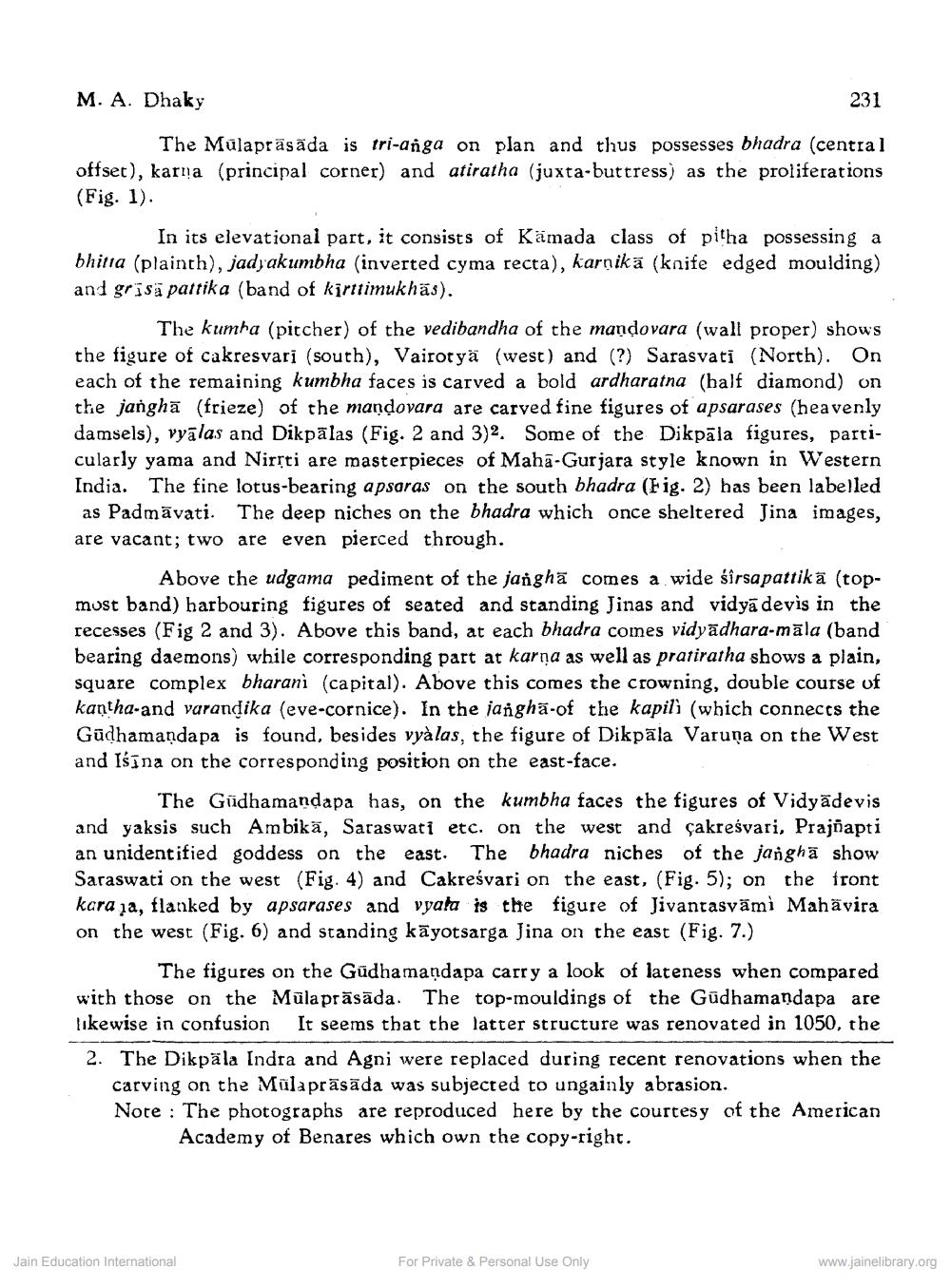Book Title: Temple of Mahavir at Ahar Author(s): M A Dhaky Publisher: Z_Jinvijay_Muni_Abhinandan_Granth_012033.pdf View full book textPage 2
________________ M. A. Dhaky 231 The Mülaprāsāda is tri-anga on plan and thus possesses bhadra (central offset), karna (principal corner) and atiratha (juxta-buttress) as the proliferations (Fig. 1). In its elevational part, it consists of Kämada class of pitha possessing a bhiria (plainth), jadyakumbha (inverted cyma recta), karnikā (knife edged moulding) and grisa patrika (band of kirttimukhās). The kumha (pitcher) of the vedibandha of the mandovara (wall proper) shows the figure of cakresvari (south), Vairotyä (west) and (?) Sarasvati (North). On each of the remaining kumbha faces is carved a bold ardharatna (half diamond) on the janghā (frieze) of the mandovara are carved fine figures of apsarases (heavenly damsels), vyālas and Dikpālas (Fig. 2 and 3)2. Some of the Dikpāla figures, particularly yama and Nirri are masterpieces of Maha-Gurjara style known in Western India. The fine lotus-bearing apsaras on the south bhadra (Fig. 2) has been labelled as Padmāvati. The deep niches on the bhadra which once sheltered Jina images, are vacant; two are even pierced through. Above the udgama pediment of the janghā comes a wide sîrsapattika (topmust band) harbouring figures of seated and standing Jinas and vidya devis in the recesses (Fig 2 and 3). Above this band, at each bhadra comes vidyādhara-māla (band bearing daemons) while corresponding part at karna as well as pratiratha shows a plain, square complex bharani (capital). Above this comes the crowning, double course of kantha-and varandika (eve-cornice). In the jarghā of the kapili (which connects the Gūdhamandapa is found, besides vyàlas, the figure of Dikpāla Varuna on the West and Iśína on the corresponding position on the east-face. The Gūdhamandapa has, on the kumbha faces the figures of Vidyādevis and yaksis such Ambikā, Saraswati etc. on the west and çakreśvari, Prajñapti an unidentified goddess on the east. The bhadra niches of the jarghā show Saraswati on the west (Fig. 4) and Cakreśvari on the east, (Fig. 5); on the front kara ia, flanked by apsarases and yyata is the figure of Jivantasyämi Mahävira on the west (Fig. 6) and standing kāyotsarga Jina on the east (Fig. 7.) The figures on the Güdhamandapa carry a look of lateness when compared with those on the Müla prāsāda. The top-mouldings of the Gūdhamandapa are likewise in confusion It seems that the latter structure was renovated in 1050, the 2. The Dikpäla Indra and Agni were replaced during recent renovations when the carving on the Mülaprāsāda was subjected to ungainly abrasion. Note : The photographs are reproduced here by the courtesy of the American Academy of Benares which own the copy-right. Jain Education International For Private & Personal Use Only www.jainelibrary.orgPage Navigation
1 2 3
